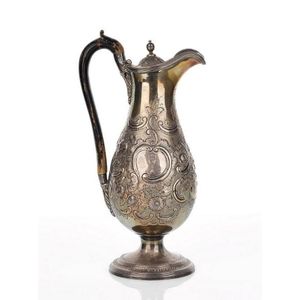Australian Silver Wine Jug with Engraved Wildlife and Jockey
You must be a subscriber, and be logged in to view price and dealer details.
Subscribe Now to view actual auction price for this item
When you subscribe, you have the option of setting the currency in which to display prices to $Au, $US, $NZ or Stg.
- Circa - A Latin term meaning 'about', often used in the antique trade to give an approximate date for the piece, usually considered to be five years on either side of the circa year. Thus, circa 1900 means the piece was made about 1900, probably between 1895 and 1905. The expression is sometimes abbreviated to c.1900.
- Engraving - The method of decorating or creating inscriptions on silver and other metal objects by marking the surface with a sharp instrument such as a diamond point or rotating cutting wheel.
- Finial - An architectural decoration, found on the upper parts of of an object. On furniture they are usually found on pediments, canopies and shelf supports. On smaller ceramic or silver items, such as spoons, they may decorate the top of the item itself, or the lid or cover where they provide a useful handle for removal.
Finials have a variety of shapes and forms. They may be urn-shaped, baluster shaped round or spiral, but usually taper into an upper point. Many real life shapes may also be used as finials, such as pineapples, berries, pinecones, buds, lotus and acorns. Sometimes animals such as a lion are depicted, or fish and dolphins. - Putto / Putti / Amorino / Amorini - A putto (plural: putti) or amerino (plural: amerini) is a cherub or cupid frequently appearing in both mythological and religious paintings and sculpture, especially of the Renaissance and Baroque periods and later used as a decorative element in the design of furniture, ceramics, statuary etc. They are usually depicted as chubby males, or of indeterminate gender, often with wings. Their depiction may represent an association with love, heaven, peace or prosperity.
This item has been included into following indexes:
Visually similar items

Silver ecclesiastical wine flagon, London, 1907 embossed with floral decoration, wood handle. Height 29 cm total weight of 794 g

A George III silver claret jug, London 1775, of baluster form, with repousse, embossed and chassed grape vines interspersed with fluted panels, the grape vine finial and shaped cover above c scroll lip, with exuberant scrolling handle, the shaped circular

A George III sterling silver baluster coffee pot by John Stamp, London 1781, 35 cm high, 825grams

A William IV sterling silver coffee pot, 1834 London, with maker's mark for possibly John Wellby, the coffee pot of compressed form with a broad neck and pedestal foot, a foliate embellished spout and 'C' scroll handle with ivory insulators, well repousse
